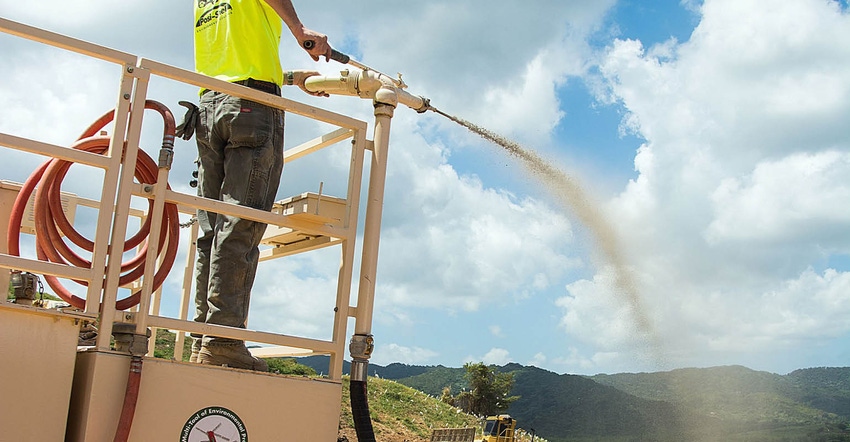The landfill saved $1.4 million in airspace by using latex paint as part of its alternate daily cover.

Three years ago, Mesa County Landfill in Colorado was facing a soil deficit and began exploring alternative covers. Today it’s using a solution that meets its cover needs while also dealing with the volumes of latex paint it receives at the site.
In this solution, operators use wasted latex paint with a spray slurry called Posi-Shell, made by LSC Environmental Products, a global manufacturer of products that address erosion, odor and other challenges in the solid waste industry. The Posi-Shell technology is a patented blend of water and powdered clay bulwarked by reinforcing fibers that keep the mixture from cracking.
“Most of the soils that we have are native clays, Mancos Shale, and sandstone,” says Barrett Jensen, solid waste director for Mesa County Solid Waste Management. “Although they exist in our borrow areas, they are difficult to excavate and are a great distance from the active face. There is also simply not enough onsite to last us for the remaining 24 to 25 years of life left in the landfill, and especially not enough for capping at the end of life,”
The Mesa campus also has an on-site, year-round hazardous waste collection facility (HWCF) that accepts wastes, including paint, from the public and local businesses. Prior to shifting to this alternative cover, all paint was shipped through a hazardous waste vendor for incineration and/or landfilling elsewhere.
The county has diverted 3,800 gallons of paint by using it in its spray application, saving approximately $11,300 in the process, Jensen says.
“This is important because the HWCF is primarily subsidized by landfill tipping fees, and to build a sustainable program while keeping our tipping fees reasonably priced, we must find innovative ways to operate and save money,” he adds.
But the biggest savings have been in airspace. Given the soil-to-cover ratio and compaction in 2016, the landfill saved $1.4 million in airspace by not using the soil it projected to utilize that year for daily cover.
“Our soil deficit is enormous. Every time that soil can be saved it is of major benefit to the facility,” Jensen says. “Ultimately, we are looking at the big picture of maximizing landfill airspace throughout the life of the landfill and the soil availability at the end of the life of our landfill.”
For daily covers the spray application can be mixed in LSC’s equipment, that LSC Environmental President Joel Lanz says is designed for a landfill; or it can be mixed in a hydroseeder.
“You would use Posi-Shell instead of soil as alternate daily cover because it’s generally cheaper than digging and moving soil daily,” Lanz says. “And it will extend the life of the landfill by between 15 to 25 percent by saving space.”
Another version of the application is an intermediate cover. It includes the addition of a durability enhancer, which is a hardening material. In this case, the shell is more impermeable, so it comes with the benefits of less erosion and less rainwater infiltration, says Lanz.
The products meet requirements of other daily and intermediate covers: controlling odors, mitigating blowing litter, deterring vectors that carry disease and helping prevent fires.
Posi-Shell is sold in bags in a powdered form and can be stored indefinitely. Other materials can be used besides latex paint, including pond water and sometimes landfill leachate.
For Mesa County, it has meant less time invested in cover upkeep. There is a little extra reporting and the additional step of stocking waste latex paint and a fairly quick process of adding it to the spray slurry mix.
Weather has played a role with the daily cover, as when there is rainfall the spray-on application can’t dry sufficiently.
“Therefore it just runs off of the working face and leaves the waste exposed. The type of waste is not an issue. But the more slope, the more angles are needed to spray the working face proficiently,” says Jensen
But the soil conservation is what most sold him.
“We need to conserve our soil for intermediate cover and capping projects,” he says. “That soil will eventually have to be purchased offsite if we are not able to come up with ways like this to keep conserving the soils that we do have.”
About the Author(s)
You May Also Like




